This article contains a list of wasps of Great Britain. The following species are of the order Hymenoptera and suborder Apocrita that is neither a bee nor ant.

Yellowjacket or yellow jacket is the common name in North America for predatory social wasps of the genera Vespula and Dolichovespula. Members of these genera are known simply as "wasps" in other English-speaking countries. Most of these are black and yellow like the eastern yellowjacket and the aerial yellowjacket ; some are black and white like the bald-faced hornet. Some have an abdomen with a red background color instead of black. They can be identified by their distinctive markings, their occurrence only in colonies, and a characteristic, rapid, side-to-side flight pattern prior to landing. All females are capable of stinging. Yellowjackets are important predators of pest insects.

Vespula is a small genus of social wasps, widely distributed in the Northern Hemisphere. Along with members of their sister genus Dolichovespula, they are collectively known by the common name yellowjackets in North America. Vespula species have a shorter oculomalar space and a more pronounced tendency to nest underground than Dolichovespula.

Vespula germanica, known colloquially as the European wasp, German wasp, or German yellowjacket, is a species of wasp found in much of the Northern Hemisphere, native to Europe, Northern Africa, and temperate Asia. It has spread and become well-established in many other places, including North America, South America, Australia, South Africa, and New Zealand. German wasps are part of the family Vespidae and are sometimes mistakenly referred to as paper wasps because they build grey paper nests, although strictly speaking, paper wasps are part of the subfamily Polistinae. In North America, they are also known as yellowjackets.

Dolichovespula is a small genus of social wasps distributed widely throughout the Northern Hemisphere. The yellow and black members of the genus are known by the common name yellowjackets in North America, such as Dolichovespula norwegica, along with members of their sister genus Vespula. In a study on the nesting biology of Dolichovespula, a colony of D. maculata with 771 workers was reported as having the largest recorded population count.
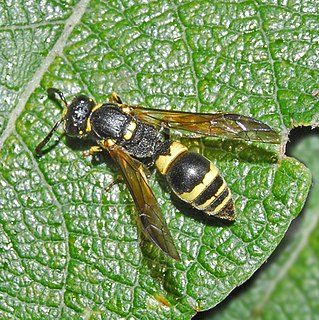
Symmorphus is a primarily holarctic genus of potter wasps.within the family Vespidae.

The Norwegian wasp is a species of eusocial wasp. It is common in Scandinavia and can also be found in Scotland and other areas in Britain and Ireland. Often known for being a tree wasp, it nests in low branches and bushes and feeds on insects. It also obtains nectar from blueberry and snowberry flowers. Although D. norwegica is rarely considered a pest in the past, a few cases of pest problems relating to them have been reported. The species is not endangered.
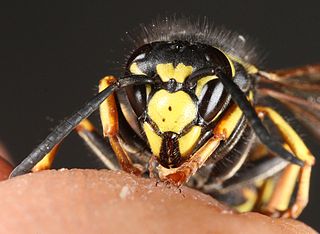
Vespula austriaca is an obligate parasitic wasp, parasitizing the nests of other species in the genus Vespula in the Old World. Its common host species include V. rufa in Europe, Japan, and East Siberia.V. austriaca wasps pollinate orchids.
Dipogon bifasciatus is a spider wasp from the family Pompilidae.
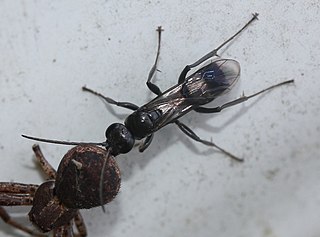
Dipogon is a genus of spider wasps of the family Pompilidae in the subfamily Pepsinae. They are found in Europe, Asia, and North America. Their generic name comes from the characteristic long bristle tufts just below the mandibles, which are used to carry material to construct the cells in the nest, and for constructing the nest.

Dipogon subintermedius is a spider wasp from the family Pompilidae.

Chrysis ignita is a species of cuckoo wasp. It is one of a group of species which are difficult to separate and which may be referred to as ruby-tailed wasps.

Chrysis viridula is a Western Palearctic species of cuckoo wasp, first described by Carl Linnaeus in 1761. Chrysis viridula is included in the genus Chrysis, and the family Chrysididae. It is a parasitoid of a number of species of eumenid wasp, mainly those in the genus Odynerus.

Symmorphus bifasciatus, the willow mason-wasp, is a species of potter wasp, from the subfamily Eumeninae of the social wasp family Vespidae which is widely distributed in the Palearctic region.
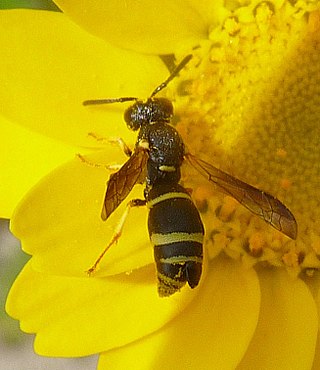
Odynerus spinipes, the spiny mason wasp, is a species of potter wasp from western Europe. It is the type species of the genus Odynerus, being first described by Carl Linnaeus in his landmark 1758 10th edition of Systema Naturae.
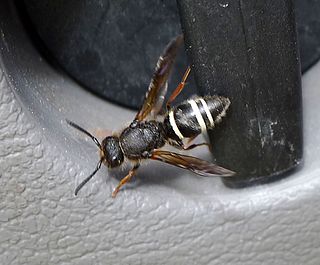
Ancistrocerus scoticus is a Palearctic species of potter wasp.

Trichrysis cyanea is a species of cuckoo wasps, insects in the family Chrysididae.

Chrysis angustula is a species of cuckoo wasps, insects in the family Chrysididae.

Chrysis fulgida, the ruby-tailed wasp, is a species of cuckoo wasp in the family Chrysididae.